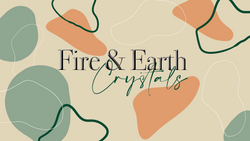Crystals have been used for thousands of years by many different cultures across the world. The oldest amulets found thus far are made of Baltic amber, some from as long as 30,000 years ago, and amber beads were discovered in Britain from 10,000 years ago, the end of the last ice age. Jet was also popular and jet beads,bracelets and necklaces have been discovered in Palaeolithic gravesites in Switzerland and Belgium.
Crystals and gemstones have played a part in many, if not all religions. They are mentioned throughout the Bible, in the Koran and many other religious texts.The bible contains one of the earliest written accounts of crystal use - the "breastplate" of the High Priest in Exodus. God is said to have instructed that 12 crystals be set in gold and inscribed with the names of the 12 tribes of Israel, to demonstrate they were under divine protection.
In the Koran, the 4th Heaven is composed of carbuncle (garnet). The Kalpa Tree, which represents an offering to the gods in Hinduism, is said to be made entirely of precious stone, and a Buddhist text from the 7th century describes a diamond throne situated near the Tree of Knowledge. The Kalpa Sutra, in Jainism, speaks of Harinegamesi the divine commander of the foot troops who seized 14 precious stones, cleansed them of their lesser qualities and retained only their finest essence to aid his transformations.
The earliest gemstone mentioned in Chinese historical texts of around 3,600 BC, is jade. Around 1600 BC, Greeks began importing precious stones via the Silk Road from India, Sri Lanka and the Far East, which they used for jewellery making and by 300 BC; they were also using semi-precious gemstones.
Ancient Greece and Rome were using sapphires, garnets and pearls between 1600 BC and 500 BC. Pliny the Elder, a wealthy Roman author, wrote a treatise on precious stones, which were used to treat ailments, in the first Century AD. One use of crystal spheres was to cauterise wounds in battle.
Crystal use in ancient Egypt goes back at least 4,500 years. Tutankhamun's funerary mask has obsidian and snow quartz eyes with a lapis lazuli band around them. Obsidian was thought to facilitate the journey to otherworld, and lapis to open spiritual sight.
In Europe, from the 11th century through to the Renaissance, a number of medical treatises appeared extolling the virtues of precious and semi-precious stones in the treatment of certain ailments. Typically stones were used alongside herbal remedies. During the Renaissance, the tradition of using precious stones in healing continued, but scientists sought to find out how the process actually worked.
Not much evidence survives of ancient Pagan practices as these were largely wiped out as Christianity spread across Europe, but there are accounts of scrying in England going back to the 5th century.
Excavation of 7th century burial clusters in southeastern England, around Kent, uncovered several small crystal spheres. Similar orbs have been found in Germanic graves, most notably along the Rhine and upper Danube, as well as in northern France, Italy, Scandinavia, and throughout the rest of Europe.
The Kent spheres were all found lying between the knees of the inhabitants of the graves - all women. The markings and wear on the crystals seem to suggest that they were regularly worn suspended from the waist.The Nenia Britannica, written by the Reverend James Douglas suggests that these spheres were magical instruments used in Pagan rituals. To support his argument, Douglas provides a lengthy account of crystal scrying in the East of England, and recounts the well-documented exploits of Paracelsus the Great, a 15th century physician and astrologer.
The earliest written reference to crystallomancy in Britain dates to ca. 450 CE. The future St. Patrick and Bishops Auxentius and Issernius convened a synod, and one of the primary edicts that resulted was a decree that condemned any Christian who believed that there was a lamia, or witch, “in the glass.” John of Salisbury (ca. 1120-1180) talked of the "... indubitably wicket ways of the crystal seers.”
F. Marian McNeill has published a very thorough study of the folk traditions in Scotland, which includes a lengthy list of magical stones (mostly crystals), their lineages, powers, and history.
References: The Encyclopaedia of crystals Judy Hall; Mystic Crystal Revelations in Ritual Practice and Folk Belief from the Iron Age to the Age of Aquarius Kathryn Presley; various online references.

